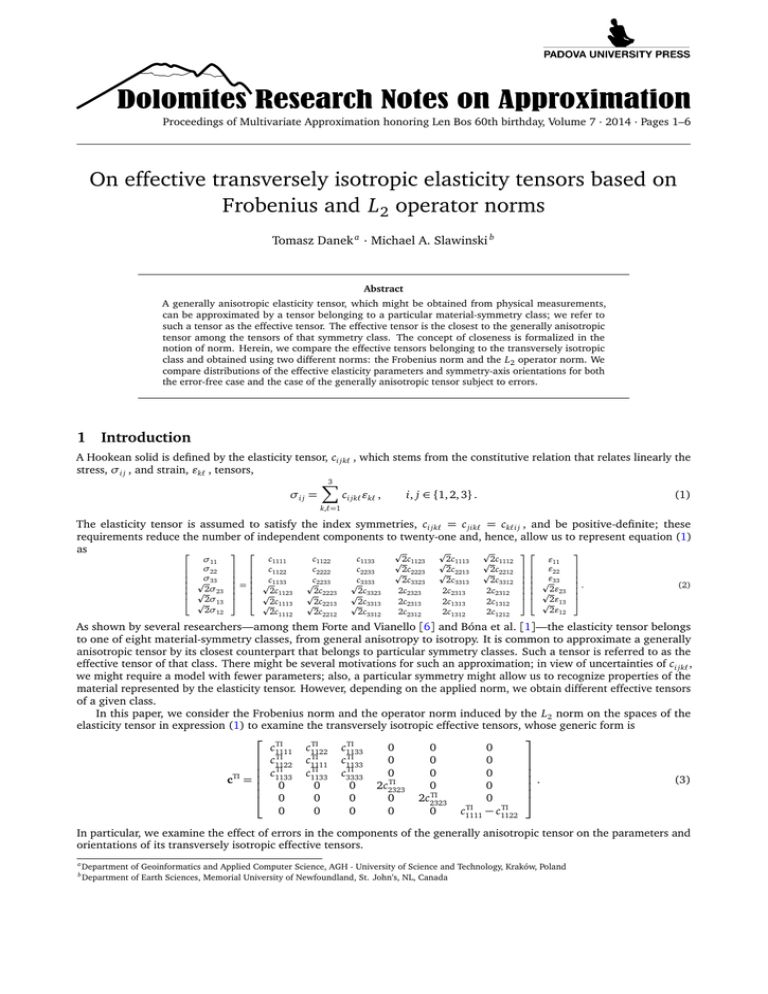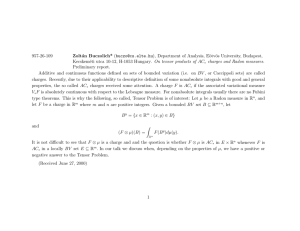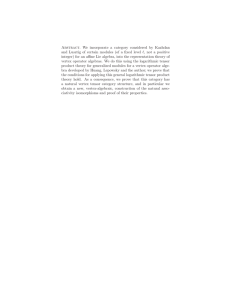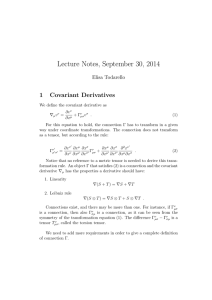On effective transversely isotropic elasticity tensors based on L operator norms 2
advertisement

Proceedings of Multivariate Approximation honoring Len Bos 60th birthday, Volume 7 · 2014 · Pages 1–6
On effective transversely isotropic elasticity tensors based on
Frobenius and L2 operator norms
Tomasz Danek a · Michael A. Slawinski b
Abstract
A generally anisotropic elasticity tensor, which might be obtained from physical measurements,
can be approximated by a tensor belonging to a particular material-symmetry class; we refer to
such a tensor as the effective tensor. The effective tensor is the closest to the generally anisotropic
tensor among the tensors of that symmetry class. The concept of closeness is formalized in the
notion of norm. Herein, we compare the effective tensors belonging to the transversely isotropic
class and obtained using two different norms: the Frobenius norm and the L2 operator norm. We
compare distributions of the effective elasticity parameters and symmetry-axis orientations for both
the error-free case and the case of the generally anisotropic tensor subject to errors.
1
Introduction
A Hookean solid is defined by the elasticity tensor, ci jk` , which stems from the constitutive relation that relates linearly the
stress, σi j , and strain, "k` , tensors,
3
X
σi j =
ci jk` "k` ,
i, j ∈ {1, 2, 3} .
(1)
k,`=1
The elasticity tensor is assumed to satisfy the index symmetries, ci jk` = c jik` = ck`i j , and be positive-definite; these
requirements reduce the number of independent components to twenty-one and, hence, allow us to represent equation (1)
as
p
p
p
σ11
σ22
σ
p 33
p2σ23
p2σ13
2σ12
c1111
c1122
pc1133
=
p2c1123
p2c1113
2c1112
c1122
c2222
pc2233
p2c2223
p2c2213
2c2212
c1133
c2233
pc3333
p2c3323
p2c3313
2c3312
p2c1123
p2c2223
2c3323
2c2323
2c2313
2c2312
p2c1113
p2c2213
2c3313
2c2313
2c1313
2c1312
p2c1112
p2c2212
2c3312
2c2312
2c1312
2c1212
"11
"22
"
p 33
p2"23
p2"13
2"12
.
(2)
As shown by several researchers—among them Forte and Vianello [6] and Bóna et al. [1]—the elasticity tensor belongs
to one of eight material-symmetry classes, from general anisotropy to isotropy. It is common to approximate a generally
anisotropic tensor by its closest counterpart that belongs to particular symmetry classes. Such a tensor is referred to as the
effective tensor of that class. There might be several motivations for such an approximation; in view of uncertainties of ci jk` ,
we might require a model with fewer parameters; also, a particular symmetry might allow us to recognize properties of the
material represented by the elasticity tensor. However, depending on the applied norm, we obtain different effective tensors
of a given class.
In this paper, we consider the Frobenius norm and the operator norm induced by the L2 norm on the spaces of the
elasticity tensor in expression (1) to examine the transversely isotropic effective tensors, whose generic form is
TI
TI
TI
c1111 c1122
c1133
0
0
0
TI
TI
TI
c1122 c1111 c1133
0
0
0
TI
TI
TI
c3333
0
0
0
c1133 c1133
TI
c =
(3)
.
TI
0
0
2c2323
0
0
0
TI
0
0
0
0
2c2323
0
TI
TI
0
0
0
0
0
c1111
− c1122
In particular, we examine the effect of errors in the components of the generally anisotropic tensor on the parameters and
orientations of its transversely isotropic effective tensors.
a
b
Department of Geoinformatics and Applied Computer Science, AGH - University of Science and Technology, Kraków, Poland
Department of Earth Sciences, Memorial University of Newfoundland, St. John’s, NL, Canada
Danek · Slawinski
2
2
Norms and distances for effective tensors
The Frobenius norm treats the square matrix in expression (2) as a Euclidean vector; it is the square root of the sum
of squared components, ci jk` . This norm exhibits the rotational invariance, which—in general—is convenient to study
anisotropy; it is used commonly in such studies (e.g., Kochetov and Slawinski [8], Danek et al. [4]).
As discussed by Bos and Slawinski [2], another matrix norm that exhibits the rotational invariance is the induced
Euclidean operator norm,
kAk2 := max kAxk2 ,
kxk2 =1
which—for A = A , as is the case of the square matrix, C , in expression (2)—becomes
t
kAk2 := max{|λ| : λ an eigenvalue of A} ;
(4)
we refer to this norm as the operator norm.
For the elasticity tensor, c , we let λ1 , . . . , λ6 be the eigenvalues of the corresponding matrix C ; then, we write
v
u 3
q
u X
ci2jk` = λ21 + · · · + λ26 ,
kck F := t
(5)
i, j,k,`=1
and
kck2 := max{|λi | : i = 1, . . . , 6} ,
(6)
which are the Frobenius and operator norms, respectively.
Æ
The former corresponds to the quadratic average of the norm of the stress over strains whose norm is unity: 6 avgk"k=1 kC"k2 =
kck F . The latter is the maximum of that quantity: maxk"k=1 kC"k = kck2 .
In view of expression (1), one could consider an operator norm induced by various norms for the stress and strain
tensors, which are second-rank tensors; for example, one could consider the matrix operator L2 norm or indeed another L p
norm. However, since the resulting norm is not the operator L2 norm of the matrix representation, C , of tensor c (L. Bos,
pers.comm., 2013), we do not consider it in this paper. Herein, the norm of the stress and strain tensors is defined as the
Euclidean length of their vectorial representations, as in expression (2).
The Frobenius-norm effective tensor, ĉ , relative to the fixed orientation is the orthogonal projection of the generally
anisotropic tensor, c , in the sense of the Frobenius norm, on the linear space containing all tensors of a given symmetry.
This projection is the average given by
Z
(g ◦ c) dµ(g) ,
ĉ :=
(7)
G sym (q)
where the integration is over the symmetry group, G sym , whose elements are g, with respect to the invariant measure, µ ,
normalized so that µ(G sym ) = 1 , as described by Gazis et al. [7]; q denotes the dependence of the value of integral (7) on
the relative orientations of c and ĉ . This integral reduces to a finite sum for the classes whose symmetry groups are finite,
which are all classes except isotropy and transverse isotropy. As shown by Gazis et al. [7], projection (7) ensures that a
positive-definite tensor is projected to another positive-definite tensor, as required by Hookean solids.
As shown by Moakher and Norris [9] and Bucataru and Slawinski [3]—in a fixed orientation of the rotation-symmetry
axis that coincides with the x 3 -axis of the coordinate system—the Frobenius-norm effective transversely isotropic tensor
derived from expression (7) has the form of tensor (3) with components given by
TI
ĉ1111
=
1
8
TI
ĉ1122
=
1
8
3c1111 + 3c2222 + 2c1122 + 4c1212 ,
(8)
c1111 + c2222 + 6c1122 − 4c1212 ,
(9)
TI
ĉ1133
=
1
2
c1133 + c2233 ,
TI
ĉ3333
= c3333 ,
TI
ĉ2323
=
1
(10)
(11)
c2323 + c1313 ,
(12)
2
are the components of the generally anisotropic tensor. No analytic form of the operator-norm effective tensor is
where ci jk`
known.
In general, the distance between the generally anisotropic tensor and its effective counterpart, ceff , expressed in the
same orientation of the coordinate system, is
d(q) = c − ceff (q) ,
(13)
Dolomites Research Notes on Approximation
ISSN 2035-6803
Danek · Slawinski
3
where q denotes the orientation dependence. For the Frobenius case, k k F , where the norm is given by expression (5),
average (7) is tantamount to the orthogonal projection, and in view of that projection, c − ĉ and ĉ are normal to one another;
hence, we can write
d F2 (q) = k c k2F − k ĉ(q) k2F .
(14)
No such simplification is possible for the operator norm due to the absence of the concept of orthogonality, and angle, in
general, since, herein, the operator norm is not an inner-product norm. Thus,
d2 (q) = c − c̃(q) 2 ,
(15)
where c̃ is the operator-norm effective tensor. In the absence of analytic expressions, we compute the components of c̃
numerically, which contributes to a difference in a computational difficulty between the Frobenius-norm and the operatornorm approaches.
In general—since expression (13) is orientation-dependent—to obtain the effective tensors, we must find the absolute
minima of expressions (14) and (15), which are the minima under all orientations of the rotation-symmetry axis. This is a
highly nonlinear problem, which we address with a global optimization method called particle-swarm optimization (PSO),
discussed by Poli et al. [10], and by invoking quaternions, as used by Kochetov and Slawinski [8] and Danek et al. [4].
For the Frobenius case, the search for the absolute minimum of expression (14) is achieved by expressing c in all
orientations of the coordinate system and, for each orientation, calculating ĉ whose components are stated in expressions (8)–
(12). Since kck is invariant under coordinate transformations, it suffices to maximize kĉk to minimize expression (14). This
is a two-variable problem, whose variables are the angles that define the orientation of the rotation-symmetry axis of a
transversely isotropic tensor.
Since no analytic form akin to expressions (8)–(12) is known for the operator effective tensor, we must search numerically
for the corresponding c̃ ; this effective tensor must have a form of tensor (3), and be such that the maximum eigenvalue of
the difference between c and c̃ is minimized; we must perform minimization under all orientations of the rotation-symmetry
axis. This is a seven-variable problem, whose variables are the two angles that describe the orientation of the axis and the
five elasticity parameters of the corresponding effective tensor, c̃ . Furthermore, one must verify that each candidate for the
effective tensor is positive-definite, as required for a Hookean solid, since—unlike for the Frobenius-effective tensor—this
requirement is not intrinsically satisfied for the operator effective tensor, as discussed by Bos and Slawinski [2].
3
3.1
Numerical example
Effective tensors
To examine differences between the Frobenius norm and the operator norm, let us compare the transversely isotropic
effective tensors obtained using these norms. To do so, we use the generally anisotropic elasticity tensor obtained from
seismic measurements by Dewangan and Grechka [5],
p
p
p
c=
7.8195
3.4495
2.5667
p
p2 (0.1374)
p2 (0.0558)
2 (0.1239)
3.4495
8.1284
2.3589
p
p2 (0.0812)
p2 (0.0735)
2 (0.1692)
2.5667
2.3589
7.0908
p
p2 (−0.0092)
p2 (0.0286)
2 (0.1655)
p2 (0.1374)
p2 (0.0812)
2 (−0.0092)
2 (1.6636)
2 (−0.0787)
2 (0.1053)
p2 (0.0558)
p2 (0.0735)
2 (0.0286)
2 (−0.0787)
2 (2.0660)
2 (−0.1517)
p2 (0.1239)
p2 (0.1692)
2 (0.1655)
2 (0.1053)
2 (−0.1517)
2 (2.4270)
,
(16)
whose entries of this matrix are the density-scaled elasticity parameters; their units are km2 /s2 . In other words, the Hookean
solid in question is completely described by expression (16). The corresponding standard deviations are
p
p
p
S = ±
0.1656
0.1122
0.1216
p
p2 (0.1176)
p2 (0.0774)
2 (0.0741)
0.1122
0.1862
0.1551
p
p2 (0.0797)
p2 (0.1137)
2 (0.0832)
0.1216
0.1551
0.1439
p
p2 (0.0856)
p2 (0.0662)
2 (0.1010)
p2 (0.1176)
p2 (0.0797)
2 (0.0856)
2 (0.0714)
2 (0.0496)
2 (0.0542)
p2 (0.0774)
p2 (0.1137)
2 (0.0662)
2 (0.0496)
2 (0.0626)
2 (0.0621)
p2 (0.0741)
p2 (0.0832)
2 (0.1010)
2 (0.0542)
2 (0.0621)
2 (0.0802)
.
(17)
As shown by Danek et al. [4], the effective tensor—in the Frobenius sense—is at the distance of 1.0733 km2 /s2 from
tensor (16) , and is given by
8.0641
3.3720
2.4588
ĉ =
0
0
0
3.3720
8.0640
2.4588
0
0
0
2.4588
2.4588
7.0817
0
0
0
0
0
0
2(1.8625)
0
0
0
0
0
0
2(1.8625)
0
0
0
0
0
0
2(2.3460)
,
(18)
with orientation determined by
q = ±(0.993636 − 0.010573 i + 0.027463 j + 0.108726 k) ,
(19)
where q is a unit quaternion, q = a + b i + cj + dk , where a + b + c + d = 1 , i = j = k = i j k = −1 , and a, b, c, d are
real numbers.
2
Dolomites Research Notes on Approximation
2
2
2
2
2
2
ISSN 2035-6803
Danek · Slawinski
4
Recall that a unit quaternion gives rise to a rotation in the space of purely imaginary quaternions, p , which are
quaternions whose a = 0 . This is a consequence of the fact that p 7→ q p q̄ , where q̄ ≡ a − b i − cj − dk is the conjugate of q ,
maps purely imaginary quaternions to purely imaginary quaternions, which we can view as vectors relative to basis {i j k} .
Also, since kpk = 1 , it follows that kqpq̄k = kpk , which means that it is a norm-preserving transformation. Thus, we can
write p0 = q p q̄ , where p0 is p rotated by
a2 + b2 − c 2 − d 2
−2ad + 2bc
2ac + 2bd
,
2ad + 2bc
a2 − b2 + c 2 − d 2
−2ab + 2cd
(20)
−2ac + 2bd
2ab + 2cd
a2 − b2 − c 2 + d 2
which is the rotation matrix corresponding to q .
The effective tensor—in the operator sense—is at the distance of 0.6022 km2 /s2 , and is given by
8.1154
3.1557
2.6736
c̃ =
0
0
0
3.1557
8.1154
2.673646
0
0
0
2.6736
2.6736
6.9239
0
0
0
0
0
0
2(1.8630)
0
0
0
0
0
0
2(1.8630)
0
0
0
0
0
0
2(2.4798)
,
(21)
with orientation determined by
q = ±(0.989244 + 0.009249 i − 0.004980 j − 0.145900 k) .
3.2
(22)
Physical quantities
Let us consider differences in physical quantities resulting from the choice of a norm. Since the velocity of the P wave along
p
the rotation-symmetry axis is c3333 , we see that the estimates based on tensors (18) and (21) are 2.84 km/s and 2.85 km/s ,
respectively; in the context of seismic measurements, this might be a negligible difference. Notably, this difference is
smaller than for the effective isotropic tensors, where—as shown by Bos and Slawinski [2]—the velocities are 2.71 km/s and
2.76 km/s , respectively. The smaller difference might be due to a larger number of parameters: two-parameter isotropic
model versus seven-parameter transversely isotropic model. A choice of a model must involve a consideration of errors
associated with ci jk` , which we examine below.
For a transversely isotropic medium, the velocity of the SH wave exhibits an elliptical dependence whose semiaxis
p
p
parallel to the rotation-symmetry axis has the magnitude of c2323 , and the other semiaxis has the magnitude of c1212 .
The ellipticity is symptomatic of the strength of anisotropy. For tensor (18), (c1212 − c2323 )/c2323 is 0.26 , and for tensor (21),
it is 0.33 ; thus, even in the context of a limited accuracy of seismic measurements, this might be a nonnegligible discrepancy
between information provided by the two norms.
A comparison of effective tensors is not complete without the examination of their orientations. Converting expressions (19) and (22) to the Euler angles—which, even though less convenient for computations than quaternions, might be
easier to visualize—we see that the orientations of their rotation-symmetry axes differ by ∆θ = 0.30◦ and ∆φ = 2.75◦ ,
where θ and φ are the azimuth and tilt respectively. Again, in the context of seismic measurements—where the axis
orientation is interpreted as the orientation of subsurface layers—this might be a negligible difference.
3.3
Perturbations
To examine the effect of errors on the distribution of results, let us consider the perturbation method, whose results are
illustrated in Figures 1 and 2. Using errors (17) and the Monte-Carlo method, we perturb tensor (16) a thousand times,
and—using either norm—find the corresponding effective tensor.
The computational effort required to find the operator effective tensors is significantly greater than to find the Frobenius
effective tensors. There are two main reasons for the increased effort.
First, as discussed in Section 2, not only the orientation—as is the case for the Frobenius norm—but also the elasticity
parameters are the subject of search. Thus, the dimensionality of the problem is increased.
Second, the maximum eigenvalue has to be computed for every solution candidate. To do so, we apply a modification of
the PSO algorithm used by Danek et al. [4] by incorporating the singular value decomposition (SVD) into the target function.
Fortunately, the well-known flexibility of PSO allows us to obtain results effectively enough to consider a perturbation
analysis.
Examining Figures 1 and 2, we see that histograms—in particular, θ and φ —obtained for the operator norm are wider.
This is a result of the optimization process, where only the maximum energy in directions of the eigenvectors is taken into
consideration; thus, global minima are found within wider basins of attraction. Also, unlike in Figure 1, histograms in
Figure 2 exhibit a lack of alignment between the maxima of empirical distributions and results obtained for the error-free
data. The understanding of this shift requires further investigation.
Dolomites Research Notes on Approximation
ISSN 2035-6803
Danek · Slawinski
7.0
2.0
7.5
2.2
2.4
3.5
8.0
2.6
2.8
4.0
−6
8.5
3.0
3.2
4.5
−4
−2
3.4
5
2.5
6.5
3.0
7.0
3.5
7.5
8.0
8.5
9.0
5.0
0
2
4
−5
0
5
10
Figure 1: Histograms of the five density-scaled elasticity parameters of the Frobenius effective transversely isotropic tensors and of the two
Euler angles describing the azimuth, θ , and tilt, φ , of their rotation-symmetry axes. These histograms are obtained from realizations of
tensor (16) subject to errors (17); black vertical lines correspond to the error-free case. [4]
7.6
1.8
3.2
−10
7.8
2.0
3.4
8.0
2.2
3.6
−5
8.2
2.4
3.8
0
8.4
2.6
4.0
8.6
2.8
4.2
5
2.5
3.0
3.0
6.0
10
−10
3.5
6.5
7.0
4.0
7.5
8.0
4.4
−5
0
5
10
15
Figure 2: Histograms of the five density-scaled elasticity parameters of the operator effective transversely isotropic tensors and of the two
Euler angles describing the azimuth, θ , and tilt, φ , of their rotation-symmetry axes. These histograms are obtained from realizations of
tensor (16) subject to errors (17); black vertical lines correspond to the error-free case.
4
Conclusions
The choice of norm has an impact on the resulting effective tensor. Differences between the operator-norm effective tensor
and the Frobenius-norm effective tensor are due to several reasons; notably, the operator norm takes into account the index
symmetry of the tensor, ci jk` = ck`i j , whereas the Frobenius norm does not.
In general, an optimization of a target function can be based on any valid criterion. Herein, both approaches can be
Dolomites Research Notes on Approximation
ISSN 2035-6803
Danek · Slawinski
6
used for perturbation methods to evaluate qualitatively the effect of errors. However, until a rigorous statistical analysis is
performed, such a distinction between the norms remains qualitative. A quantitative statistical analysis can be done using
maximum-likelihood estimators, which require error-weighted norms. Such an approach is under investigation.
Be that as it may, it is important to recognize that, while tensor (16) is a mathematical analogy for physical properties of
a material measured by Dewangan and Grechka [5], tensors (18) and (21) are approximations of that tensor. Two distinct
mathematical approximations referring to the same physical object remind us of an obvious, yet commonly neglected,
distinction between the physical world and the realm of mathematics.
Acknowledgments
We wish to acknowledge discussions with, and contributions of, Len Bos and Misha Kochetov; the input of the former was
instrumental in our considering the operator norm; the input of the latter was important in addressing reviewer’s comments.
Also, we wish to acknowledge the graphic and editorial support of Elena Patarini and David Dalton, respectively.
This research was performed in the context of The Geomechanics Project supported by Husky Energy. Also, this research
was supported partially by the Natural Sciences and Engineering Research Council of Canada and by the Polish National
Science Center under contract No. UMO-2013/11/B/ST10/04742.
References
[1] Bóna, A., Bucataru, I., Slawinski, M.A., Material symmetries of elasticity tensors. Q. J. Mech. Appl. Math. 57(4) 583–598 (2004)
[2] Bos, L., Slawinski, M.A., 2-norm effective isotropic Hookean solids. J. Elast. (2014 in press: DOI 10.1007/s10659-014-9497-y)
[3] Bucataru, I., Slawinski, M.A., Invariant properties for finding distance in space of elasticity tensors. J. Elast. 94(2), 97–114 (2009)
[4] Danek, T., Kochetov, M., Slawinski, M.A., Uncertainty analysis of effective elasticity tensors using quaternion-based global optimization
and Monte-Carlo method. Q. J. Mech. Appl. Math. 66(2), 253–272 (2013)
[5] Dewangan, P., Grechka, V., Inversion of multicomponent, multiazimuth, walkaway VSP data for the stiffness tensor. Geophysics 68(3),
1022–1031 (2003)
[6] Forte, S., Vianello, M., Symmetry classes for elasticity tensors. J. Elast. 43(2), 81–108 (1996)
[7] Gazis, D.C., Tadjbakhsh, I., Toupin, R.A., The elastic tensor of given symmetry nearest to an anisotropic elastic tensor. Acta Crystallogr.
16, 917–922 (1963)
[8] Kochetov, M., Slawinski, M.A., On obtaining effective transversely isotropic elasticity tensors. J. Elast. 94(1), 1–13 (2009)
[9] Moakher, M., Norris, A.N., The closest elastic tensor of arbitrary symmetry to an elastic tensor of lower symmetry. J. Elast. 85(3),
215–263 (2006)
[10] Poli, R., Kennedy, J., Blackwell T., Particle swarm optimization: An overview. Swarm Intelligence 1(1), 33–57 (2007)
Dolomites Research Notes on Approximation
ISSN 2035-6803





